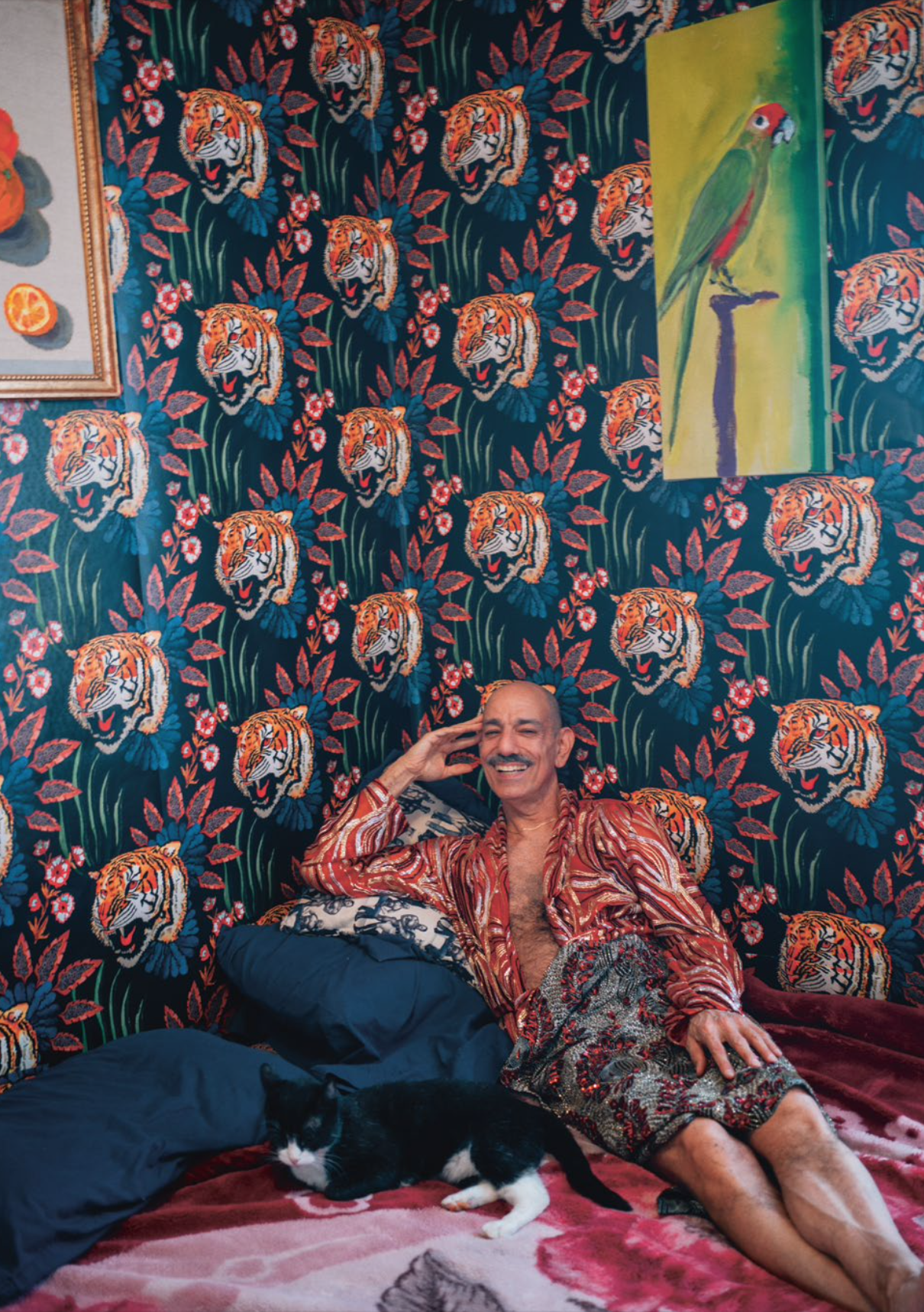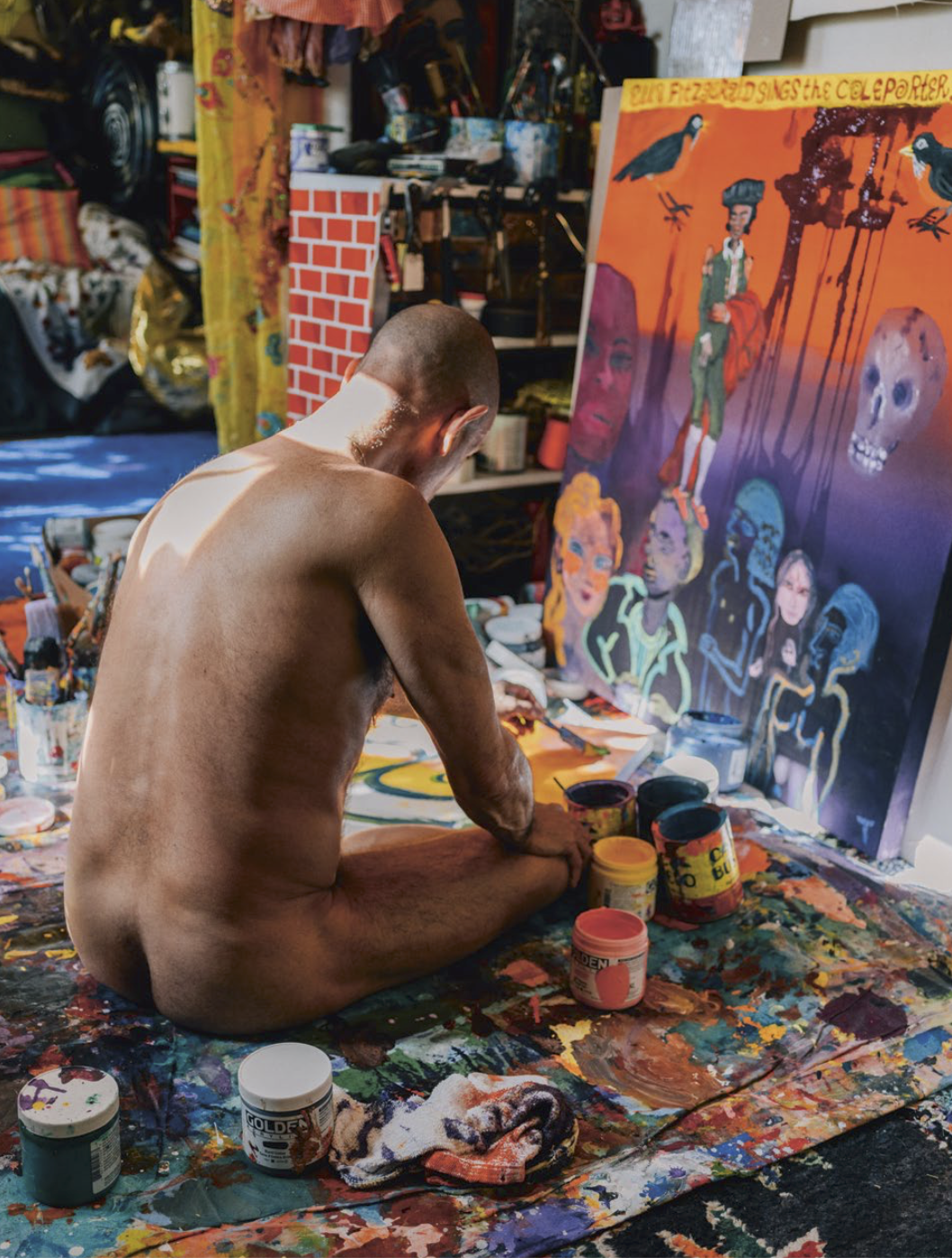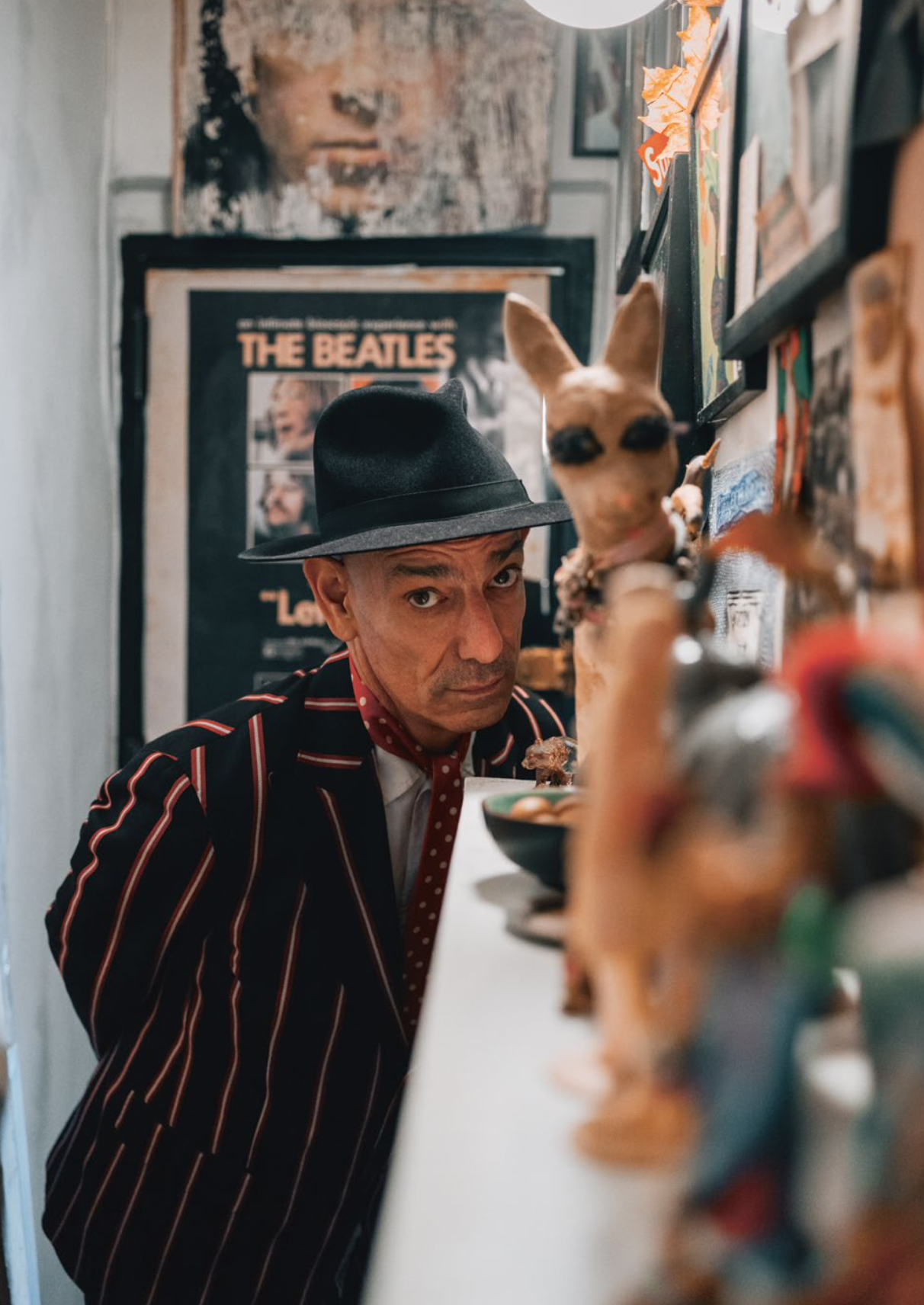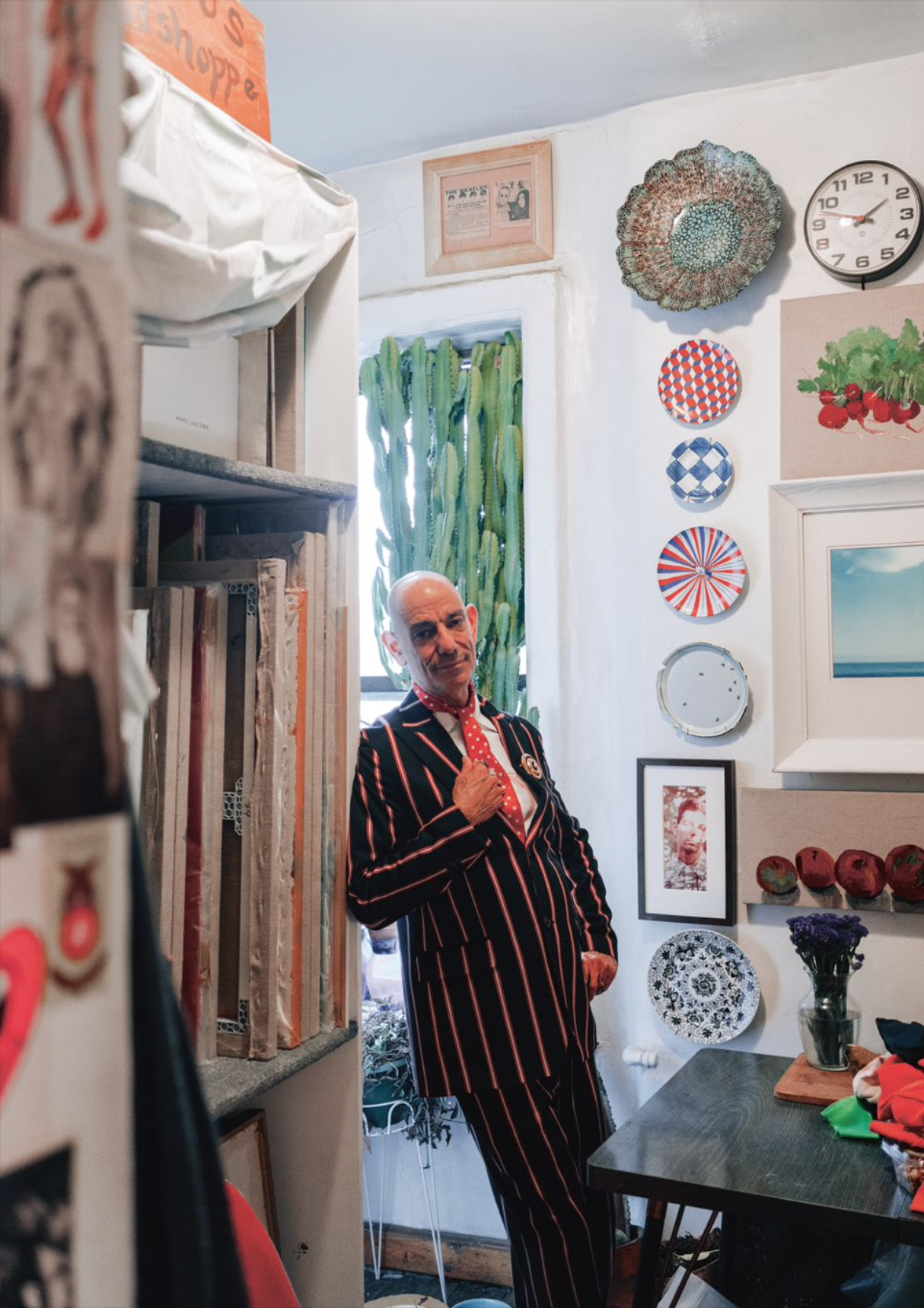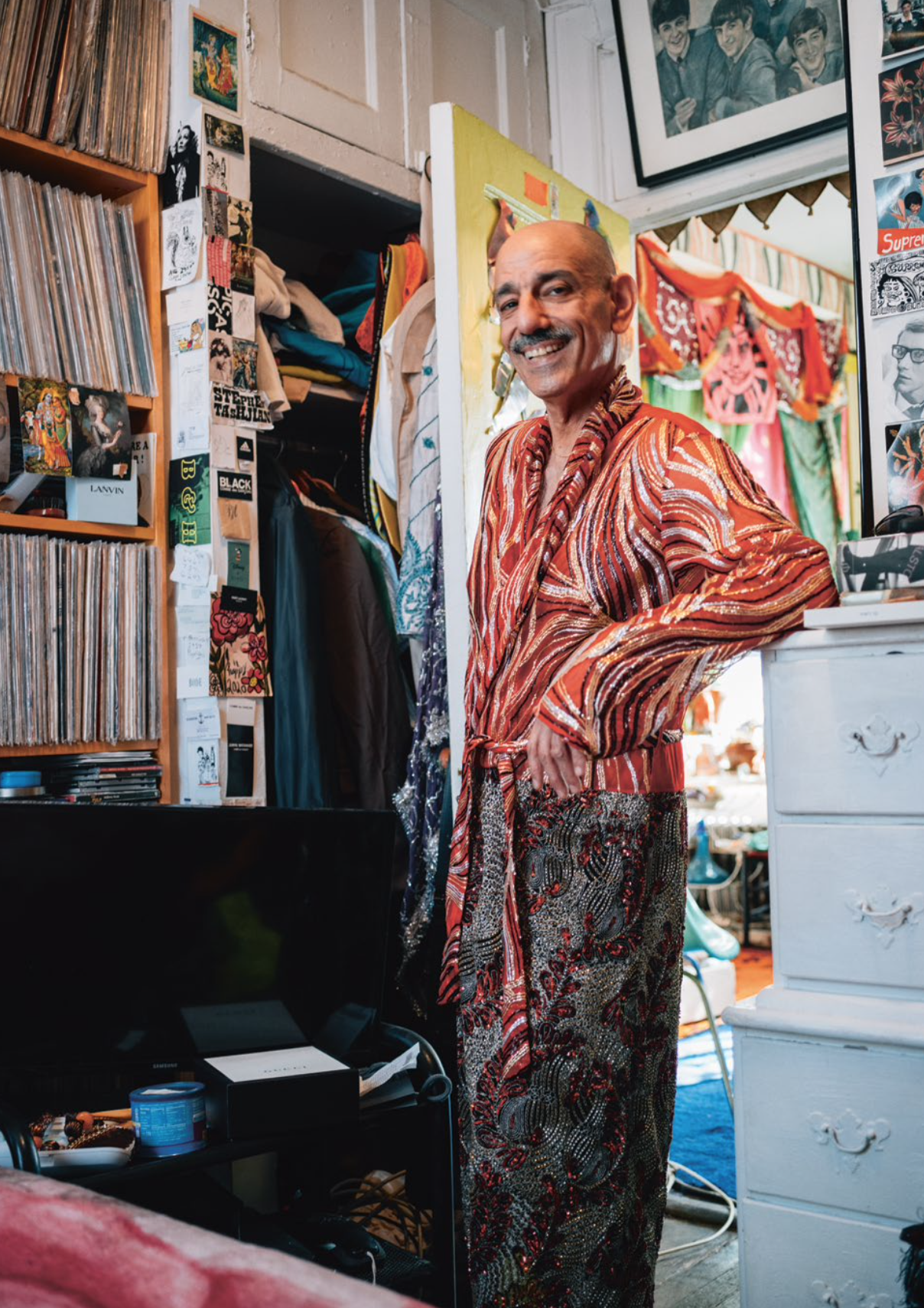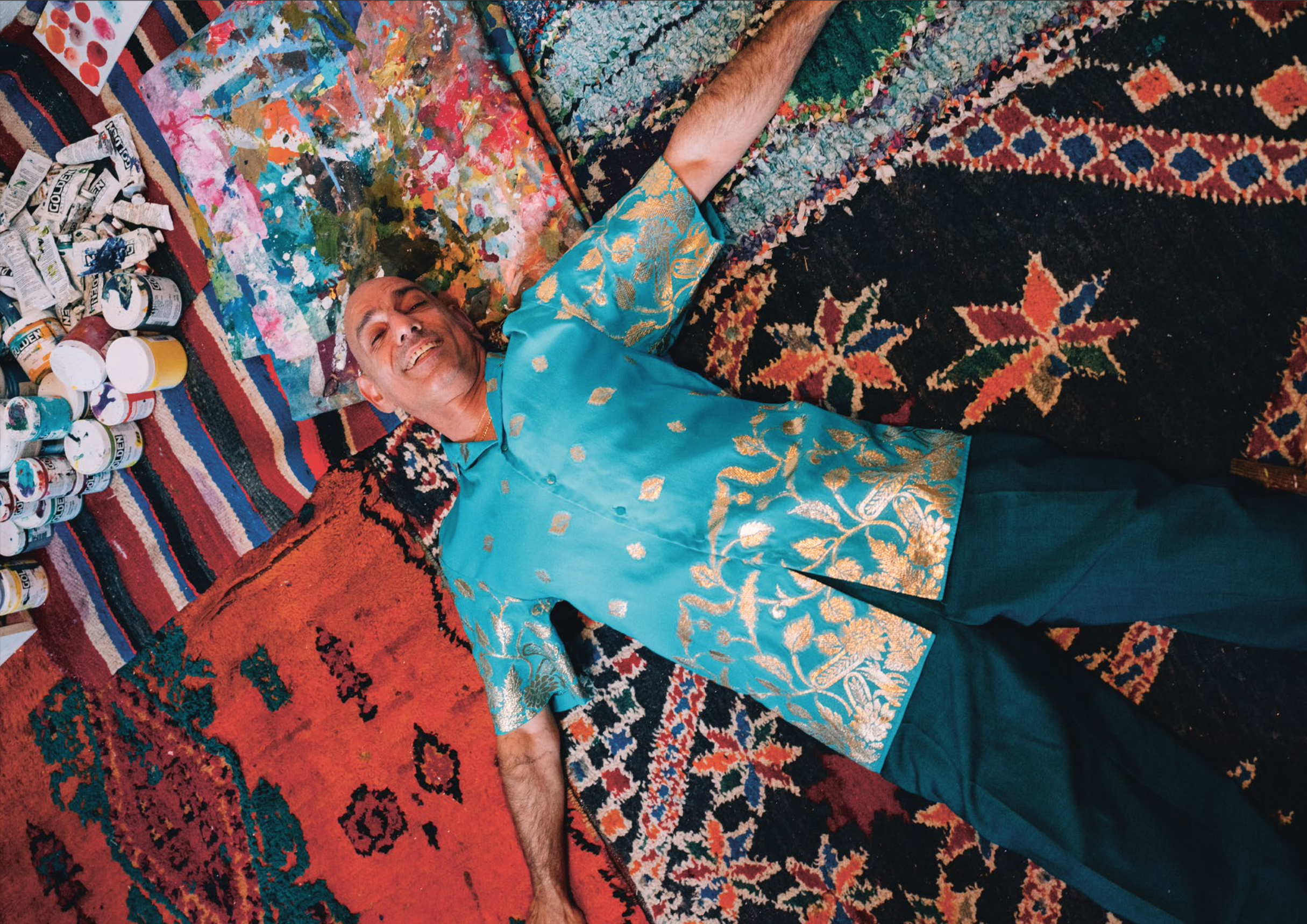TABBOO!
Interview by Michael Bullock
and Anne Hanavan
Photography by Jack Pierson
Apartamento 27, 2021

TABBOO!, aka Stephen Tashjian, has entered an exciting new stage in a life already jam-packed with excitement. The artist’s formative years were spent in parallel schools of culture: the art world and the drag world. He created a routine in which days were spent making paintings and nights were spent performing, with neither form of expression more important to him than the other. Revered for his impactful presence in nightlife, he came up during New York City’s mega club heyday—the ‘80s and ‘90s—with now mainstream stars Leigh Bowery, RuPaul, and Lady Bunny. True to his moniker, TABBOO!’s stage persona is unexpected, irreverent, and magnetic, sharing more with performance art than contemporary drag. Iconic moments such as the 1993 Wigstock debut of his sexual freedom anthem ‘It’s Natural’ have secured his legendary status, but the last few years have marked a shift in the appreciation of his talents. For decades, drag fame thwarted a welcome reception from an uptight artworld. To say it more directly: gatekeepers wouldn’t take a drag queen seriously as a painter. But the recent collective soul-searching of most cultural institutions—in regard to their poor handling of marginalised people and their histories—has resulted in an overdue correction in TABBOO!’s favour. Finally his work is being fully embraced, leading to the inclusion of his paintings in exhibitions at MoMA, the Jewish Museum, and ICA Boston, among other institutions, and he is currently preparing for a forthcoming double show of cityscape paintings at Karma and Gordon Robichaux (the gallery that represents him), accompanied by the release of two new books.
The godfather of glitter’s fifth-floor one-bedroom walk-up is located on East 5th Street, in the heart of the East Village, where he has resided since he moved to New York. His home/studio has always been a vital organ for the city, pumping out brilliance, joy, and glamour for almost four decades, not only keeping the neighbourhood’s historic, colourful art scene alive but thriving. TABBOO! is that rare artist who fully lives out the bohemian ethos in which their whole life—every waking thought and action—is art. His home serves as an archive of queer East Village culture, painting studio, art storage, and stage set. Stepping through its threshold you become part of his show. All your senses are ignited: ‘70s pop music plays on the record player, a huge wall of vintage puppets excites, while large painted canvases inspire. All of this interspersed with intriguing collages comprised of photographs of musicians and politicians, many created by the artists in his squad, contemporaries from the Boston School: Mark Morrisroe, Gail Thacker, David Armstrong, Nan Goldin, and Jack Pierson (his friend and former roommate, who took the photos for this story). The passway from the painting studio into the living room is a makeshift stage, created by a curtain comprised of super saturated green, pink, and aqua fabrics from India. Lounging on his multicoloured sofa, you feel as if you’re backstage in a Broadway theatre’s green room, eagerly awaiting TABBOO!’s next magically magnificent monologue.
Anne Hanavan: I’ve introduced your plays many times at the Howl! gallery, the Gene Frankel Theatre, and for your incredible show in commemoration of Stonewall’s 50th anniversary. How about we start this interview the same way? ‘Ladies, gentlemen, and everyone in-between! I, Anne Hanavan, along with Michael Bullock, am pleased to present to you a rare glimpse into the wonderful world of TABBOO!’
TABBOO!: Bravo! Thank you, Anne.
Michael Bullock: I read that the first thing you did when you moved to NYC was open an art space with the visionary gallerist Pat Hearn?

TABBOO!: In 2021 you can be gay anywhere, and with the internet you can have an art gallery anywhere, but back in the late ‘70s, early ‘80s, unless it was New York City, you may as well give up. Before I moved here, I lived in Boston; the Fiorucci store in Harvard Square had magazines, so I knew about Klaus Nomi and the Mudd Club and realised, ‘Something’s happening in New York City’. I went once on a school trip and thought, ‘Oh my god, it’s so gay!’ The West Village gay disco scene was happening. The East Village was all punk rock, new wave, and it was artsy. When I went back to Boston I told Pat, ‘We’re moving to New York immediately!’ We threw everything we had—which was basically stolen stuff from Salvation Army—into garbage bags, rented a van, and ended up in Soho. When we got there we wondered, ‘What do we do?’ and we thought, ‘Let’s just open a gallery’. There was a little former deli for rent between Avenue B and C, so we turned that into the Pat Hearn Art Gallery—the acronym is PHAG. I was the fag and she was Pat Hearn and we ran the gallery together. It really pushed the East Village into a whole art scene; there ended up being galleries in every available storefront. There was the Fun Gallery, and Gracie Mansion had just started.
Anne: Were you painting at that time?
TABBOO!: I’ve always done the same thing. I’ve painted the same subject matter in the same way, worn the same kinds of clothes, painted my apartments the same way, collected the same things, had the same friends—finally now it’s all gelling. It’s wild. I just found a little drawing I did when I was four years old, and it’s similar to my current paintings with the exact same birds.
Anne: Can we see it?
TABBOO!: I don’t know. Unfortunately, my house is like Jenga. People might think I’m a hoarder, but I do purge every once in a while, because then you can make room for more! Even with plants. In the ‘80s Jack Pierson lived here, and he grew a grapefruit tree from a seed. It received such beautiful light that it became enormous, but eventually it got bugs. So I cut it down and thought, ‘Good, onto the next, make room for something else’. I rescue a lot of my stuff. I find it in the garbage or in thrift shops.
Michael: Was this the first New York apartment you lived in?
TABBOO!: It’s my second place, after living with Pat in Soho. But I moved within the first month of being here in 1982. Strangely enough, I’ve never moved. I’ve stayed here and watched everything else move. The culture, the economy, the style. At one point this neighbourhood was all gay, at another it was all Puerto Rican. Then it was all drug dealers. Currently it’s a mix of drug dealers, Dominicans, and gays, but these days it’s mostly NYU students. When I first lived here, there was nothing on this block; it was all completely bombed out all the way to the river.
Michael: Was this originally built as a tenement building?
TABBOO!: It is, but it wasn’t built as one, because all the tenement buildings were made so cheaply that most of them collapsed. That’s what made way for all these big, new, fancy, modern buildings everywhere. This building must have been built for slave masters or something because it’s so big and solid and the ceilings are so tall. In the hallways, underneath all the white paint, it’s marble. When I moved in, graffiti artists lived here and they graffitied everything. The name of the building is the Mildred. They didn’t name tenement buildings.
Anne: In 1982 did it ever cross your mind that you might stay here forever?
TABBOO!: I didn’t know there was a forever. I don’t really read because I have bad dyslexia, but I knew that 1984 was a book about the end of the world. I really believed that; I thought maybe I was going to live for two more years. I figured I would move to New York City so at least I’d end on a high note. So, all the art I made was on found pieces of garbage paper or trash. I wasn’t thinking that anything I made would ever end up in a museum.
Michael: It’s unusual for a close-knit circle of artists in their early 20s to all go on to become so influential and also remain friends. Besides Pat Hearn and Jack Pierson, the group included Nan Goldin, Mark Morrisroe, Gail Thacker, David Armstrong, and the designer John Derian—a talented aesthetic family now commonly referred to as the Boston School.
TABBOO!: John’s Armenian, too. Growing up, I didn’t know any other Armenians besides my brothers. Armenians were the target of the first genocide of the 20th century. Hitler based the genocide of the Jews on the genocide of the Armenians. So the Armenians who came to America either really got into being Armenian in small clusters or denied that they ever were and just didn’t want to talk about it, because their families were slaughtered in front of them. I never knew anything about my heritage, and John is one of the rare Armenians that I know.
Michael: Being here, it’s clear that your place shares such a strong sensibility with him. I wonder if you might be his muse?
TABBOO!: Or he might be my muse; it’s both. I love his stuff. If I could, I would put a John Derian piece on every wall of this place. For instance, these weird little papier-mâché birds—they’re here somewhere. I found them at his shop. This sculpture looks like a creepy John Derian piece, but it’s not. I just found it on the street. Is it shabby chic? What do they call it now? I don’t know. Colourful garbage? I want more colourful garbage.
Anne: Did your circle of friends set out to tackle New York together? Was hyper-ambition a defining characteristic?
TABBOO!: Again, I didn’t even think I could have a career. When we started out it wasn’t even 10 years after Stonewall. You still couldn’t really even publicly be gay. You definitely couldn’t be gay on TV. I would have loved to have my own TV show. Did I think that it could be a possibility? Hell, no! Could you make gay work in the art world? Hell, no! I knew Warhol: even he was closeted until the day he died. I never could hide being gay, but did I think for a second that that would stop me from doing what I wanted to do: be an artist, performer, painter, costume designer, wearing beautiful clothes, writing songs and stories, and creating shows? Hell, no! Because I’d always done them, blindly, without fear, and I could care less what anyone else thought. For instance, in third grade I marched into school and said, ‘OK, I’m going to do a show now. The teacher’s response: ‘Please, will you sit down?’ ’No, I’m going to do a show now!’ And I would have already made the costumes at home out of construction paper.
Michael: Where did you grow up?
TABBOO!: Cherry Valley, a neighbourhood in Leicester, Massachusetts, outside of Worcester. It was very small. I don’t think there were even 120 people in my graduating high school class. Growing up, I always just did stuff. I was already on the cover of a newspaper for my puppet shows when I was 14. I knew I was a star. I’m going to be 62 next month, so it’s taken a while for the world to catch on, but I’ve had some celebrated moments—never a whole lot of money, but little bits of fame for influential things I’ve done.
Anne: Such as your collaborations with Supreme and Marc Jacobs, or your overall influence on typography. Your collaborations with Deee-Lite and your cover art for their album World Clique helped define a dominant ‘90s sensibility.
TABBOO!: Like that. Yes! That also started in grade school when I would tell the class, ‘I’m going to do a show’. I would insist that I was in charge of the bulletin boards. I’d create everything and write the words to announce my shows. So I was already doing public art installations right from the start. Do you remember Rocky and Bullwinkle’s ‘Fractured Fairy Tales’? They used that kind of curly lettering that I emulate.
Michael: Usually, flamboyant boys that have your high level of charisma and bravado are forced to tone it down and conform to generic standards.
TABBOO!: ‘Will you stop flitting around the house?’ How many times did I hear my father say that to me. I won’t denigrate him, but let’s just say he wasn’t into me being me.
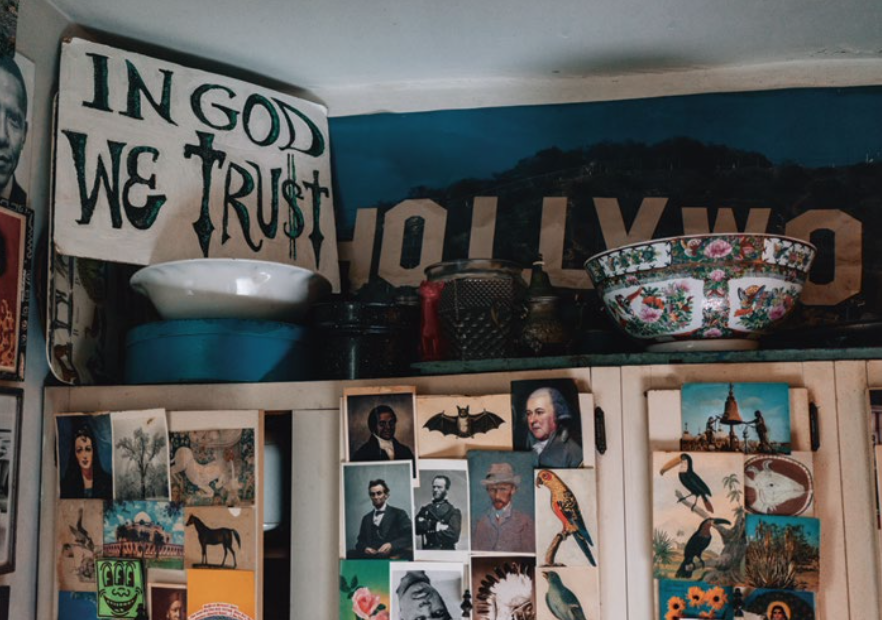
Anne: Clearly that never broke your spirit?
TABBOO!: Yeah, because I’ve always believed that you can’t stop me. At different points I thought to myself, ‘It’s just not working. I’ll never make a dime’. And I would get some kind of stupid sales or restaurant job, where I’d literally be a fish out of water, and I’d think, ‘I can’t do it, I’m just going to have to kill myself’. It really gave me suicidal thoughts. Then I would tell myself, ‘You’re going to kill yourself over this stupid job? Fuck that shit’. And within minutes, I’m back doing shows, doing paintings. So I never stopped making my stuff; whenever I did stop it was torture. Obviously you have to pay the bills, but—I don’t know how people stop pursuing their dreams. I think that’s what gives people brain aneurysms or heart attacks. It wasn’t a matter of, ‘Am I going to stop doing what I do?’ I never would. Sometimes people ask, ‘Oh, are you still painting?’ And I say, ‘Are you still left-handed? Do you still have blue eyes? Are you still gay?’ I know I’m an artist. Nothing can change that. Obviously, there’s Darwin’s theory of survival of the fittest: you have to adapt. Adapt or die. That’s supposedly why, I don’t know, I think birds turned into lizards, turned into mammals, turned into humans—you have to adapt, as the climate changes, as technology changes. I’ve had to as well. There were times in the mid ‘80s when there were so many huge clubs that would pay me thousands or hundreds to do my thing. ‘Just show up and do whatever you want!’
Michael: Which clubs were you favourite to perform at?

TABBOO!: Oh, so many were fun! The Pyramid, which is just at the end of my street, was a hoot. It was gay-run and -operated. It was almost all drag queens, but when it wasn’t a drag night it was hardcore punk or hillbilly bands. The Pyramid was the centre of the East Village. Also, when Susanne Bartsch ran the Copacabana, which also had an incredible drag scene. Those were the days of Willi Ninja, when—pre-Madonna—voguing really hit big. The Rock ‘n’ Roll Fag night at The World was magnificent. Dean Johnson was this rock star, gay porn star who ran it, and I was the hostess, so we would have all kinds of people there. It was so big, The B-52’s and Talking Heads shot videos there. Robert Plant, David Bowie, Neil Young—everyone would show up. The Limelight: that was a crappy place, but it was colourful and they paid a lot. Lady Bunny, RuPaul, and I all worked there. The promoter loved me because in an instant I would turn up and be colourful. The crowd would look at me and go, ‘Wow, you can dress like that? Oooh’. I was the grandmother of those club kids.
Anne: How did you first get that moniker, TABBOO!?
TABBOO!: I was always aware of show business. The biggest stars never keep their real name. Judy Garland is not her real name. Joan Crawford is not her real name. To me, the most popular showbiz names are singular: Cher, Elvis, Charo, Prince. Back in the early ‘80s, part of the influence on our scene was the psychedelic culture of the ‘60s. I hung out with a girl named Wendy Wild. We were all doing LSD and smoking pot; it was the ‘60s, but in the ‘80s. At that point I had only done small shows on weeknights, and Wendy invited me to headline her Solid Gold night at Pyramid on a weekend. She said I couldn’t do it without a drag name. I didn’t want a woman’s name, because I’m not transgendered. I’m just a boy doing drag as a show. So I was looking at records and came upon this instrumental record called Taboo. I have always loved Polynesia. I love aqua, as you can see. The word ‘taboo’ comes from the Polynesian concept ‘tabu’, which is about the rules and prohibitions around something sacred. I also liked it because it starts with a T and A, just like my family name. I thought, ‘Let’s make it even funnier’; in the ‘60s everything had an exclamation point, so I referenced that and added one. ‘Let’s also spell it with two B’s’. I wasn’t saying that doing drag is taboo, although it still was back then. I figured if I added an extra B, it wouldn’t share the exact same meaning. It’s TABBOO! but not taboo. Once I had a drag name the queens at the club—especially the manager—immediately insisted on calling me TABBOO! all the time. From then on I was booked in every show. Did I go out of my way to stick with it? Did I ever think I’d live here forever? No, it just all happened. I think everything is preordained somehow.
Anne: And what about your most recent shows?
Again, adapt. Right? I used to do lots of shows. When I stopped drinking and drugging I stopped going to nightclubs, plus venues just dried up because of Giuliani. There weren’t too many good clubs left to do a show in, so pre-pandemic I performed at galleries. When Covid hit I started doing lots of music videos and posting them to Instagram. My only rule is that each video is always made in just one take. I put all my energy into them because, at the time, all the art supply stores were closed, so I couldn’t paint. Like I said before, I have to be me; if I can’t do the colours on canvas, I need to do colours with the fashion and videos. I started making those videos really upbeat; I would dance and sing or lip sync or I’d do a puppet show. Right off the bat, people said, ‘Oh my god, you’re bringing light into my life. You’re making me happy in this dark, horrible time’. Even Jerry Saltz DM’ed me saying, ‘You’re saving the world. Keep it coming, keep it coming, keep it coming’. In the art world, you get maybe one show every two years. I need three shows every day. And why not? Who’s the blonde-headed queen from CNN? Anderson Cooper. He has two and a half hours on television every day. So why can’t I have six minutes?
Michael: Do you approach painting the same way you approach performance?
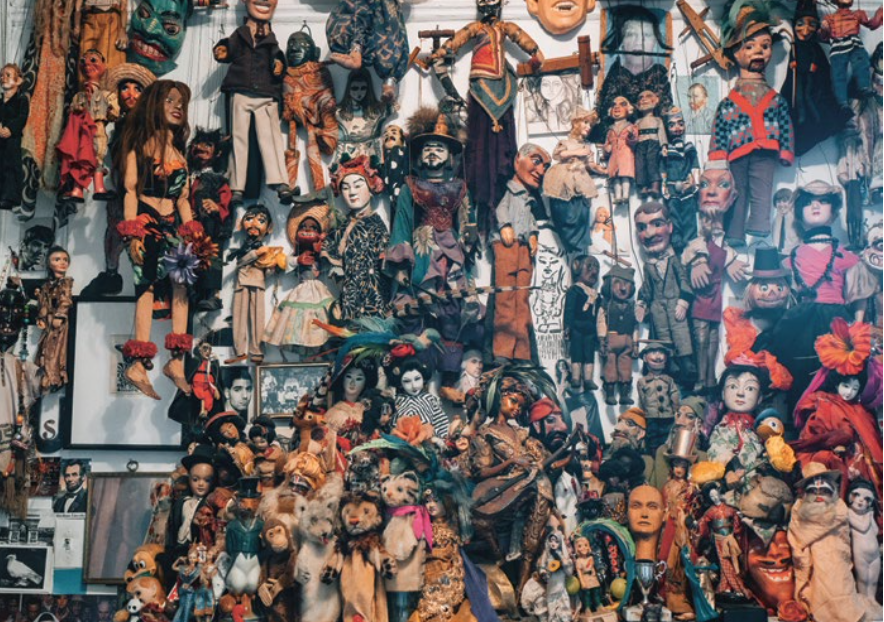
TABBOO!: It’s very similar. It’s also a one-shot deal. It’s very Zen; I don’t know if that’s the right word. I make sure I have all the tools I need to complete it, and then I just do it. I don’t stop. I don’t doubt myself. I don’t even know what I’m doing when I’m making it. I’m not necessarily consciously thinking. It just happens.
Anne: Like a meditation or a trance?
TABBOO!: I think I’m in the real moment of life, which is one of the great things about doing it in the early, early morning: the phone’s not ringing, you don’t hear the cars outside, almost no one is awake.
Michael: What subjects do you enjoy painting?
TABBOO!: The classics: people, places, and things. I’m always told by collectors, ‘Your paintings really make me happy’. A lot of the time they hang them in their kids’ rooms because they’re colourful and friendly and positive. Have I done negative? I don’t really do overly conceptual, dark, or scary. When they are scary, it’s cartoon-scary like The Addams Family.
Anne: I love that photo of Abraham Lincoln in your living room.
TABBOO!: He’s a left-handed artist, president, and wonderful person. I’d like to say old friend, but—
Michael: Abraham Lincoln was an artist?
TABBOO!: He was a poet, yeah. His speeches were beautiful poetry.
Anne: You’ve even performed his writing.
TABBOO!: Yeah, I love it.
Anne: The two themes of this conversation are adapting and persevering. What’s your biggest life lesson? I mean, what would you tell young drag queens or painters or queers? What’s your advice to them?
TABBOO!: I go two ways on this. One is: don’t give up the dream. If you love what you do and you’re good at it, keep going, even though the money and the fame may not be there. And it may never be there. In fact, 99.9999 percent of the time, it’s never there. But on the other side of the coin I think, ‘If you’re doing something and you’re really not making any money, maybe you’re really not any good at it and you should move onto something else’. I just saw the Fran Lebowitz documentary. She said, ‘I love to sing, but that doesn’t mean I need to inflict it on the world’. I’ve always thought I was talented and funny and stylish, and I’ve always got positive feedback from people that I considered successful. For instance, it was no surprise to me when Elton John flipped over my artwork. Why wouldn’t he? He’s got 100 songs that everyone can sing at the drop of a hat. He’s talented. He’s good, so he knows what’s good. Does that make sense? What I would say is just keep going and try to stay healthy, because it all comes back around. And what you think may never happen could; things actually do change, believe it or not. I would have never thought, for instance, that a gay man would be our secretary of transportation or that there would be a woman vice-president, never mind that she’s both Black and Indian, wo-wooo! Incredible!
